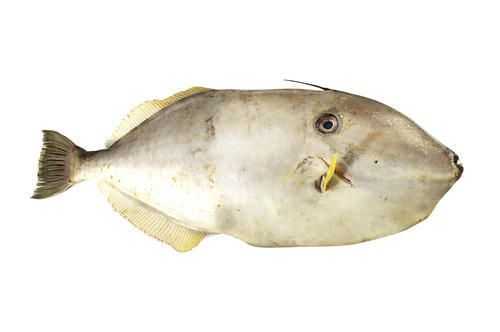Leatherjacket

Species Details
Oligoplites Saurus
Carangidae
Perciformes
Coral Reefs, Sand, Inshore, Nearshore
8 - 10 lbs.
10" - 14"
Leatherjacket (Oligoplites Saurus) Fish Description
The leatherjacket is a long, silvery fish that is about 10-11 inches long. It has a blue-green body that may have a yellow tinge, and the skin is ridged with many short grooves that give it a leathery look.
This particular species is often misidentified as two other breeds - a long-jaw leatherjack that possesses a more protruding jaw, and a short jaw leatherjack, which has a jaw akin to its namesake.
As it matures, the leatherjacket will shift its diet. The young will begin feeding on ectoparasites and fish scales when acting as a parasite itself. Once they are fully mature, a leatherjacket will have a diet consisting of small fish like anchovies, and will also consume shrimps, mysids, and macroalgae.
Leatherjackets are not usually fished for human consumption and have no real commercial contribution, but they have a good flavor for those that know how to handle this fish.
Interesting Facts About the Leatherjacket
- This game fish’s darkened dorsal and anal fin spines are linked to poisonous glands that can inflict significant pain that can last for days.
- Young leatherjackets have been seen adorning a “leaf-mimic” position, wherein they float on the water’s surface with their heads pointed downward and their tails bent upwards
Leatherjacket Size
The leatherjacket is a large fish that has been observed to be between 10 inches at a minimum and to grow to 14 inches in length. The highest weight recorded is at 10.1 ounces.
Leatherjacket Habitat & Distribution
The leatherjacket’s natural habitat in the western Atlantic Ocean ranges from Maine in the United States to the northern tip of the Gulf of Mexico and has also been spotted south of Uruguay. Sightings have also occurred in the eastern Pacific Ocean, from California in the United States, and Mexico to Ecuador.
The leatherjacket can be located inshore, on sandy beaches, inlets, and bays. It shows a preference for murky and muddy conditions. They do congregate in populous schools that move rapidly and can jump out of the water. When breeding in early spring to midsummer, they prefer shallow inshore spots.
Leatherjacket Fishing Technique
Leatherjackets are considered to be fast nippers and can skillfully get the bait off the hook. They are accessible at any time all year round. The most popular fishing approach is bait fishing, whether on a small boat or the shore.
A #1 to #3/0 hook size range with a shank length of 8 to 12 would fit with any angler posting in an estuary. Based on the depth of the water and the presence of a current, the size of the sinker is your preference. Let the sinker build a scarcely visible bend in your rod, but do not let it rest on the bed's bottom. The style of leader is also your choice, whether it's a knot or a swivel.
It is important to use small bait, and anglers will be pleased that almost anything will work. Prawns, squid, and worms work quite well. If using fillets, make sure the pieces are small and salted - tuna, mullet, or slimy mackerel are excellent options.
If you’re lucky enough to happen by a school, leatherjackets will nip at anything. Using oily and fleshy baits such as prawn, salmon, garfish, and mussels would guarantee you a catch.
Use a short leader and rig, so you can feel even the smallest bites quickly and give your bait a good jig off the bottom from time to time. A light 1-3 or 2-4 kilo spin rod that is 7 feet long would work well, paired with a light 1000-2500 reel and a 4-pound line and leader. Due to their sharp teeth, you can expect thinner lines to get cut occasionally.
Is a Leatherjacket Fish Good to Eat?
Leatherjacket fish are considered edible but are not commonly eaten. Some people find them tasty, while others find them too bony or tasteless. It is important to note that leatherjacket fish have sharp spines that can be dangerous if not removed properly. Additionally, leatherjacket fish have been known to accumulate toxins, so it is recommended to avoid eating them in areas with high pollution levels.
What Does Leatherjacket Fish Taste Like?
Leatherjacket fish, also known as leatherjacket, is a type of fish with a mild and light taste that is slightly sweet. This makes it an ideal addition to a range of dishes, whether they be baked, grilled, fried or poached. The meat of a leatherjacket fish has a firm texture that can hold up well to cooking, and its mild flavor makes it versatile enough to pair with a wide variety of ingredients. Leatherjacket fish is often used in seafood stews and curries because its sweet and delicate taste adds depth and richness to the dish. Its flavor also pairs well with strong and spicy seasonings, making it a favorite ingredient in many Asian cuisines. Whether served as a main dish or as an ingredient in other recipes, leatherjacket fish offers a delicious taste that is sure to please even the most discerning palate.
Moreover, the taste of leatherjacket fish is not only budget-friendly, but also versatile in terms of cooking methods. It can be grilled, fried, baked, or steamed, allowing for a range of flavor profiles to be achieved. Additionally, its mild taste makes it a great option for those who are not fans of fishy flavors. One can enjoy the firm and meaty texture of leatherjacket fish without being overwhelmed by an unpleasant taste. Overall, the taste and texture of leatherjacket fish make it a great addition to any seafood lover's repertoire, and a valuable ingredient for those looking for an affordable and delicious alternative to pricier seafood options.
How to Cook Leatherjacket Fish for Maximum Flavor
The flavor of the Leatherjacket can be maximized by starting with a high-quality fresh filet. It is important to look for a filet that is firm and shiny with no dull spots or discoloration. The texture of the fish should be smooth and it should not have a strong or unpleasant smell. When cooking the leatherjacket fish, it is best to keep it simple to let the natural flavor of the fish shine through. Pan-frying, grilling or barbecuing with minimal seasoning are great ways to bring out the delicate taste of this fish. Adding lemon or lime juice can also enhance the flavor of the leatherjacket fish. Overall, selecting a fresh and premium quality leatherjacket filet is key to enjoying the distinct and delicious taste of this fish.
When it comes to cooking leatherjacket fish, seasoning plays a crucial role in bringing out its unique taste. An essential step in the cooking process is to season the filet properly. A simple mixture of olive oil, garlic, salt and pepper can work wonders on this fish, elevating its flavor profile to new heights. Leatherjacket fish has a distinct taste that can be described as mildly sweet and nutty, with a slightly gamey flavor.
What is the History of the Leatherjacket Fish?
The history of the Leatherjacket fish dates back to the early 19th century when the first specimens were collected and described by naturalists. Since then, numerous species have been identified, with new ones being discovered periodically.
Leatherjacket fish have been known to be important prey for some larger fish species and are also consumed by humans in some cultures. Some species are also kept as aquarium pets.
In recent years, the Leatherjacket fish has become a concern in some areas due to their invasive characteristics, as they can outcompete native species and cause ecological imbalances. As such, some countries have had to introduce measures to control or limit their populations.







